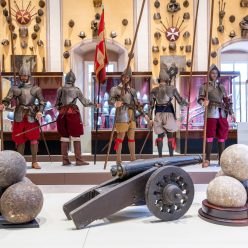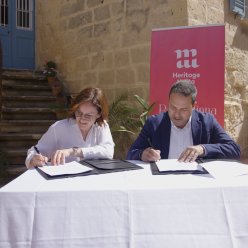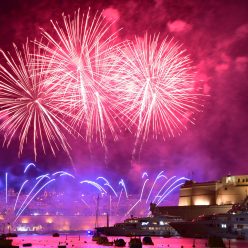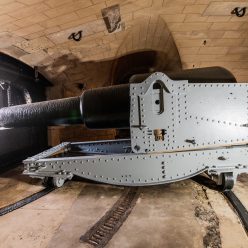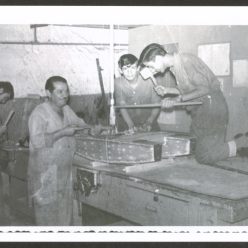By Sarah Yeomans and Warren Bugeja.
From banners and pennants billowing aloft ancient battlefields to Jolly Rogers fluttering on the horizon, flags have always been used to communicate messages across distance.
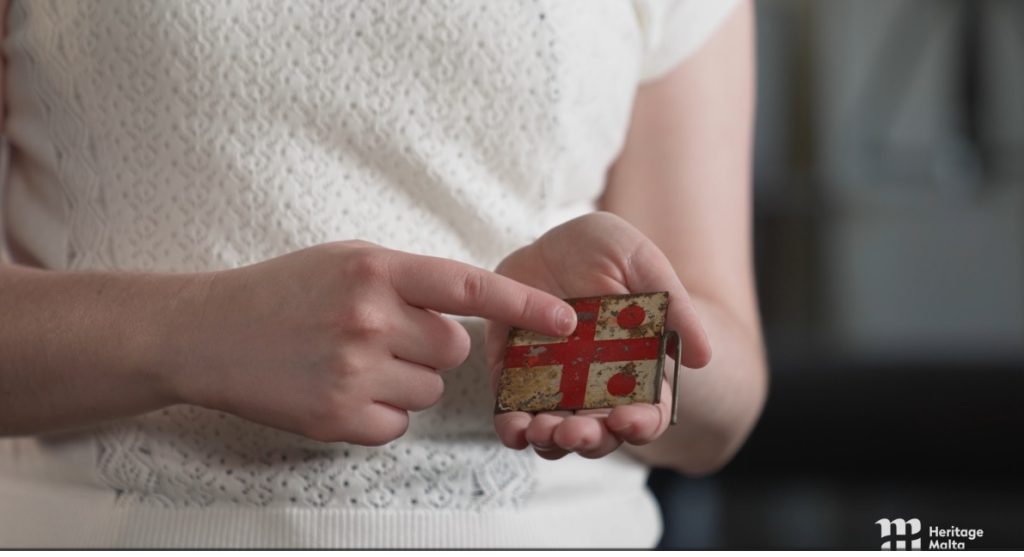
Sarah Yeomans, Coordinator – Heritage Researcher (EEA Projects), deposits a strange-looking contraption on a table in the Malta Maritime Museum. She explains that the Flag Naval Signalling Box, also called a Tufnell Box after the man who invented it, is her artefact of choice for Heritage Malta’s HM TV series ‘Treasure To Meet You.’ The wooden box, dated between the 1930s and the 1950s, opens into two trays. The top tray of the apparatus consists of two hinged brass arms at each end of the tray, as well as two smaller arms that rise vertically, resembling the masts and yards of a ship. The masts are each equipped with loops designed for hanging the flags through the hooks attached to each of the latter from the mast side. The lower tray features compartments arranged into labelled groups, such as ‘alphabetical flags,’ ‘numeral flags,’ ‘aircraft carrier flags,’ ‘Admiral’s flags,’ and ‘Special Flags’. Indeed, the presence of an ‘Aircraft carrier flag’ dates the box to the interwar or wartime period. Altogether, around 275 and 300 small representations of naval signal flags are stored in these compartments. The flags can be attached to the masts, allowing pairs of trainees at each end to practice against their partner’s signals.

Born in 1857, Lionel Tufnell achieved the rank of Lieutenant in 1881 and later served as Flag Lieutenant to Rear Admiral Erskine near the Irish Coast in 1888. In 1895, he advanced to the position of Commander, and his expertise in using homing pigeons for communication caught the attention of the US Navy. As a result, Commander Tufnell was appointed the first Royal Navy Superintendent of Signal Schools in the same year, a post he kept until 1898. He invented this practical box as a simple and effective means of teaching to be used by naval school students practising naval signalling.
Sarah selected this artefact of the national collection due to its composite nature as it “represented a complex challenge to research.” “It was quite interesting to learn the meaning of each flag and how they were used in communication between ships,” she elaborates. Sarah wanted to elicit “connections between artefacts that are found within the Malta Maritime Museum collection”, which will also assist with how they are interpreted and displayed once the Museum reopens. For example, a painting within the maritime collection depicting “Armed Forces of Malta Condor Class Patrol Boats P30 and P31” showing the boats flying signalling flags helped provide context for the Tufnell box. Similarly, early twentieth-century photographs found in the Malta Maritime Museum’s Photographic Archive, such as one showing HMS Sussex dressed for the birthday of King George V on 3 June 1932, also gave insight into the different usage scenarios of these signalling flags. “It was particularly rewarding to work with the Digitisation Department on the 3-D scanning and professional photography of the signalling box,” Sarah enthuses. A three-dimensional model of the box will also be created to be potentially implemented in the exciting future digital interpretation of the Museum.

Learning the International Code of signalling flags was especially intriguing because it provided a comparison between the one message the International Code can transmit with a sole flag versus other meanings that the flag portrayed throughout the years. Sarah points to a flag divided into three sections: a blue mid-section with yellow bands above and below. The universally understood message is “I am manoeuvring with difficulty”. However, in an account of 1937, Sarah found that the same flag could also symbolise a ‘destroyer’ ship. Another flag which was of particular interest to the researcher was the various types of signals indicating the rank of the Admiral on board. Yeomans picks up a flag intersected with a red cross on a white field. Two red balls on the side of the mast represent a Rear Admiral, whilst one red ball represents a Vice Admiral, she explains.
The Tufnell signalling box was used up until the 1970s, when its popularity started to diminish. Although no longer in use, the box remains a symbol of humanity’s need to communicate and the ingenuity of creating international codes and systems to do so without words.
Watch the feature here in English or Maltese
‘Treasure to Meet You’ is uploaded to Heritage Malta’s Facebook page every fortnight on a Tuesday at 19:00. The intimate series consists of short features in both English and Maltese versions. Each fortnight, viewers get to meet one of our dedicated curators, who were asked to select an artefact or feature from the national collection to which they are particularly attached.


